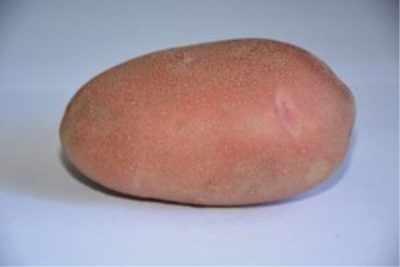
- Authors: Belarus
- Appointment: dining room
- Tuber size: large
- Tuber weight, g: 60-90
- Peel color: red
- Color of the pulp: light yellow
- Starch content,%: up to 14.0%
- Tuber shape: oval and elongated-oval
- Peel structure: smooth
- The soil: effectively uses the natural fertility of the soil
Belarusian varieties of potatoes are very popular among gardeners and farmers, which are characterized by quick adaptation to growing conditions, high yields and excellent taste. The early ripe potato Palats is considered a striking representative of the Belarusian selection.
Breeding history
The palace is a novelty created by Belarusian breeders in 2017. Due to the fact that the potato variety is still undergoing variety trials, it is not yet listed in the State Register. The nightshade crop can grow in almost any region of the Russian Federation.
Description of the variety
The early potato is a compact, undersized bush with an erect central stem, moderate thickening with large dark green leaves, and a developed root system. 8-10 tubers ripen under each bush. During the flowering period (mid-June), large red-purple flowers are formed on the bushes, collected in lush inflorescences.
Characteristics of the appearance of the bush and root crops
The palace belongs to the category of large-fruited potato varieties. The average weight of the root crop reaches 60–90 g. The shape of the vegetable is leveled, oval or elongated-oval with a smooth surface. The color of the tubers is pale red. The peel is thin, strong, sparsely covered with small eyes, planted superficially.
The dug out potatoes are excellently transported over long distances, and can also be stored for a long time without losing their taste and marketability. You need to store the tubers in a dark and cool basement, where there is no excessive moisture, which provokes the appearance of sprouts.
Purpose and taste of tubers
Belarusian potatoes have an excellent taste. Light yellow pulp is dense, without powdery and watery. When peeling, the flesh of the root vegetables does not darken.
Boiled potatoes practically do not boil, do not lose their shape. The pulp contains up to 14% starch, as well as vitamin C, B vitamins, beta-carotene, anthocyanins, valuable acids. Dug up roots can be boiled in a peel, baked, added to salads and soups, stewed, stuffed, you can make mashed potatoes from them, make blanks (freeze).
Maturation
The palace is an early ripening variety. It takes 50–70 days from germination to harvest. The first digging can be done in 45-50 days (July). It is recommended to dig out all the potatoes fully ripe - in August. Full ripening is indicated by yellowed tops, which are previously removed.
Yield
The nightshade crop is declared as a high-yielding crop. By providing your potatoes with basic care, you can count on a good harvest. About 550-600 centners of large tubers are dug from 1 hectare of plantations. In the conditions of a summer cottage or garden, about 400 kg are dug out on one hundred square meters. The maximum yield was 65 tons of dug potatoes from 1 hectare of planting.
Growing and care
Potatoes are planted in late April - early May. It is recommended to plant tubers with stably heated air and soil. As a planting material, medium-sized tubers are selected without damage and with processes 1.5–2 cm long. Potatoes when planting do not require very deep holes: 8–10 cm is enough. Optimal for planting is a 35x75 cm pattern. You can plant tubers in several ways, but the most common one is “under the shovel”.
Care for early potatoes provides for watering as the soil dries, weeding and loosening the row spacings, thereby increasing air permeability and removing weeds, hilling (twice a season), applying mineral and organic fertilizers (three times during the growing season), preventing viruses and fungi, as well as pest infestations.

Planting potatoes is one of the main spring activities traditional for Russian gardeners. There are many ways to plant this vegetable, allowing you to get a good harvest in different conditions and climates. Before planting, you need to carefully prepare the planting material, correctly determine the timing, competently prepare the soil.


Soil requirements
Potatoes have no special requirements for the quality and composition of the soil. The plant grows comfortably on loose, breathable, moisture-permeable, fertile and non-acidic soils. If the level of acidity in the soil is increased, then it is enough to add dolomite flour. It is not recommended to plant tubers in lowlands, where there is excessive stagnation of moisture, so that the rhizomes do not hurt. In addition, it is good if the groundwater table is deep (2–2.5 m).

Required climatic conditions
Potato Palace is a heat-loving culture, drought-resistant and resistant to slight temperature fluctuations. For planting, it is recommended to choose a clean and flat area that is abundantly illuminated by the sun, where there is no stagnation of moisture and there is protection from drafts.
Disease and pest resistance
The plant has a good immune system, so potatoes are rarely exposed to various diseases. The culture is absolutely resistant to aureus nematode, potato crayfish and viruses. Average resistance of the variety to fusarium, black scab, alternaria, common scab and late blight of leaves. Among the pests that attack potatoes, it is worth noting only the Colorado potato beetle, which can be dealt with using insecticides.

Potatoes are a popular vegetable crop that many gardeners planted on their site. But growing a bountiful harvest of tasty and large tubers is unlikely to succeed if the beds are not properly protected from the most common diseases and pests. Often, the development of diseases of various etiologies of potatoes goes unnoticed, so it is important to identify the problem in time and eliminate it.
















































































